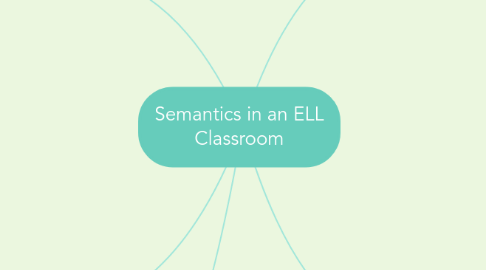
1. In the Classroom
1.1. Activities
1.1.1. Analysis Charts
1.1.1.1. Teachers can pick a category related to a topic, find key words, and make a chart that has features shared by some of the words for students to complete prior to starting the lesson. Students can place a plus or a minus dependent on if the word has that feature or not. A question mark can illustrate if a student doesn't know. In small groups, students can discuss the words and symbols and then later after the lesson is finished, edit their signs in their charts (Hussain & Sajid, 2015).
1.1.2. Word Cards Activities
1.1.2.1. In small groups or individually, students can use word cards or picture cards to create word families by categories, synoyms, or matching pronouns and nouns.
1.1.3. Mind Maps
1.1.3.1. Mind maps would be very useful in helping students to help students map out similarities or meanings of words, and the ways that they might be related to each other.
1.2. Very useful in language acquisition to teach students to understand the meaning words can have, instead of focusing solely on the function of a word within a sentence. For English language learners, can be difficult because they have to understand lexical and colloquial usage of words at times, but once they are able to understand the importance of semantics it can be very useful.
2. Semantic Features
2.1. Semantic components are useful in studying a language it helps us to notice sentences that might seem "odd" or "strange" due to the certain elements we might characterize different words (Hussain & Sajid, 2015).
2.2. A word in a language should be viewed as a "container" that carries meaning components because words carry more meanings that basic types of features (Hussain & Sajid, 2015).
3. References:
3.1. Aronow, R., & Bannar, K. (2016, April 17). Semantics: Thematic roles. Retrieved from Semantics: Thematic Roles Hussain, S., & Sajid, S. Semantics in EFL classroom: A brief review. IOSR Journal Of Humanities And Social Science (IOSR-JHSS), 20, 39-43.
4. About Semantics
4.1. the study of meaning within a language (Hussain & Sajid, 2015)
4.1.1. Conceptual Meaning: meaning conveyed by the literal usage of a word
4.1.2. Associated Meaning: different people have different associations for certain words; not concerned a part of the conceptual meaning (Hussain & Sajid, 2015)
4.2. "Focuses on the relationship between signifiers, like words, phrases, signs, and symbols, and what they stand for, their denotation" (Hussain & Sajid, 2015, p. 35)
4.3. Alongside signifers, facial expression, body language, and proxemics have meaning as well (Hussain & Sajid, 2015)
4.4. A main concern of semantics is how meaning is attached to large pieces of text, possibly as a result of composing smaller units of meaning (Hussain & Sajid, 2015)
5. Thematic Roles of Semantics
5.1. Agent and Theme
5.1.1. In Semantics, the agent is the one who does the action of a verb while the theme is is the action of the verb that is being carried out (Aronow & Bannar, 2016.)
5.2. Instrument and Experiencer
5.2.1. An instrument is the being in which the action of the verb is being carried out while the experiencer is the being that goes through an emotion, state of being, or perception due to the verb (Aronow & Bannar, 2016.)
5.3. Location, Source, and goal
5.3.1. Location is the place where the verb takes place, source is the direction of where the action starts, and the goal is the where the action of the verb moves (Aronow & Bannar, 2016.)

